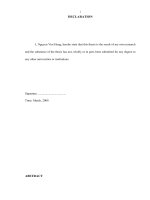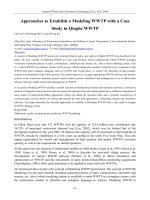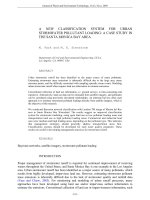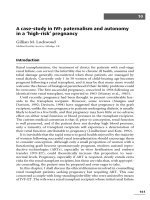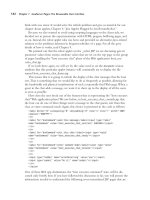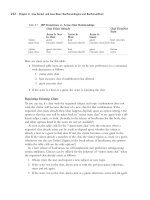- Trang chủ >>
- Khoa Học Tự Nhiên >>
- Vật lý
moral understandings a feminist study in ethics sep 2007
Bạn đang xem bản rút gọn của tài liệu. Xem và tải ngay bản đầy đủ của tài liệu tại đây (1.85 MB, 325 trang )
MORAL UNDERSTANDINGS
Studies in Feminist Philosophy is designed to showcase cutting-edge monographs and collections that display the
full range of feminist approaches to philosophy, that push feminist thought in important new directions, and that
display the outstanding quality of feminist philosophical thought.
STUDIES IN FEMINIST PHILOSOPHY
Cheshire Calhoun, Series Editor
Advisory Board
Harry Brod, University of Northern Iowa
Claudia Card, University of Wisconsin
Lorraine Code, York University, Toronto
Kimberle Crenshaw, Columbia Law School/UCLA School of Law
Jane Flax, Howard University
Ann Garry, California State University, Los Angeles
Sally Haslanger, Massachusetts Institute of Technology
Alison Jaggar, University of Colorado, Boulder
Helen Longino, Stanford University
Maria Lugones, SUNY Binghamton
Uma Narayan, Vassar College
James Sterba, University of Notre Dame
Rosemarie Tong, University of North Carolina, Charlotte
Nancy Tuana, Penn State University
Karen Warren, Macalester College
Published in the series:
Abortion and Social Responsibility: Depolarizing the Debate
Laurie Shrage
Gender in the Mirror: Confounding Imagery
Diana Tietjens Meyers
Autonomy, Gender, Politics
Marilyn Friedman
Setting the Moral Compass: Essays by Women Philosophers
Edited by Cheshire Calhoun
Burdened Virtues: Virtue Ethics for Liberatory Struggles
Lisa Tessman
On Female Body Experience: “Throwing Like a Girl” and Other Essays
Iris Marion Young
Visible Identities: Race, Gender and the Self
Linda Martín Alcoff
Women and Citizenship
Edited by Marilyn Friedman
Women’s Liberation and the Sublime: Feminism, Postmodernism, Environment
Bonnie Mann
Analyzing Oppression
Ann E. Cudd
Self Transformations: Foucault, Ethics, and Normalized Bodies
Cressida J. Heyes
Family Bonds: Genealogies of Race and Gender
Ellen K. Feder
Moral Understandings: A Feminist Study in Ethics, Second Edition
Margaret Urban Walker
MARGARET URBAN WALKER
MORAL UNDERSTANDINGS
A FEMINIST STUDY IN ETHICS
SECOND EDITION
2007
1
Oxford University Press, Inc., publishes works that further
Oxford University’s objective of excellence
in research, scholarship, and education.
Oxford New York
Auckland Cape Town Dar es Salaam Hong Kong Karachi
Kuala Lumpur Madrid Melbourne Mexico City Nairobi
New Delhi Shanghai Taipei Toronto
With offices in
Argentina Austria Brazil Chile Czech Republic France Greece
Guatemala Hungary Italy Japan Poland Portugal Singapore
South Korea Switzerland Thailand Turkey Ukraine Vietnam
Copyright © 2007 by Oxford University Press, Inc.
Published by Oxford University Press, Inc.
198 Madison Avenue, New York, New York 10016
www.oup.com
Oxford is a registered trademark of Oxford University Press
All rights reserved. No part of this publication may be reproduced,
stored in a retrieval system, or transmitted, in any form or by any means,
electronic, mechanical, photocopying, recording, or otherwise,
without the prior permission of Oxford University Press.
Walker, Margaret Urban, 1948–
Moral understandings: a feminist study in ethics / Margaret Urban Walker. –2nd ed.
p. cm. — (Studies in feminist philosophy)
Includes bibliographical references (p. ) and index.
ISBN 978-0-19-531539-4; 978-0-19-531540-0 (pbk.)
1. Feminist ethics. I. Title.
BJ1395.W35 2007
170.82—dc22 2006052763
987 654321
Printed in the United States of America
on acid-free paper
1
For my mother,
Virginia Sullivan Urban,
with love
This page intentionally left blank
PREFACE TO THE SECOND EDITION
The first edition of Moral Understandings: A Feminist Study in Ethics was
written a decade ago. It was my first book, and I am now amused by the fact
that I believed I was writing principally to those practitioners of moral theory
in the mode that the book relentlessly critiques, what I call the “theoretical-
juridical” paradigm. I was on a mission, and I did not grasp until after the
book’s publication that its reception would, predictably, be strongest among
those who already felt alienated from moral philosophy in the dominant
modes, as well as many who simply would find something in the book that is
useful for the kind of work in which they were already engaged. The fortress
of theoretical-juridical moral philosophy did not totter before my onslaught;
yet things change, however slowly. In professional philosophy, things change
very slowly. I hope that this edition of Moral Understandings will continue to
contribute to that change, but I now see its contribution differently. I have
been grateful for the broad reception the book has already achieved in quite
varied quarters. I have been excited by the book’s reaching younger philoso-
phers and graduate students. It is my hope that they learn to integrate the
questions the book raises and the critical perspective it urges into their
broader repertoire in ethics and then that they struggle in creative ways with
the reflective disequilibrium the amalgam produces.
The alternately exhilarating and frustrating fortunes in academic philos-
ophy of all work that bears the tag “feminist” has unquestionably shaped the
book’s audience. I still find that many philosophers do not understand that
viii PREFACE TO THE SECOND EDITION
“feminist ethics” is more like Kantian, or Aristotelian, or utilitarian ethics than
it is like, say, environmental ethics or biomedical ethics. It is not a subject mat-
ter but a method of approach with certain prior convictions about human
agency, knowledge, and society. I see feminist ethics as one such approach
within moral philosophy conceived as the continuing project of exploring the
form and content of answers to the question “how shall we live?” Moral
Understandings argues that some of the form and content of twentieth-
century ethics cannot be defended, and need to be reconsidered. It is a femi-
nist study in ethics because it locates a set of epistemological problems of
moral and moral-theoretic importance by paying attention to how gender and
other determinants of social authority, power, and recognition affect the
moral life about which some of us make ethical theories, as well as the theo-
ries we make. Not all of us have had a voice in this tradition of ethical reflec-
tion and theory making. This is just a fact of history up to very recent times
about who has authored our Anglo-European canonical tradition of ethical
theory: it is men and not women; people with leisure and education and not
those who work with their hands and backs; people in the relatively comfort-
able sectors of affluent societies and not those struggling for survival either in
those societies or beyond them; and white people of European descent in soci-
eties that have persistently seen others who are not white and European as
standing lower in a racial hierarchy that still haunts our culture and politics,
locally and globally. Because this is a fact, the questioning of how that fact has
shaped our canonical representations of moral life is surely in order. It is hard
to see how moral philosophy can proceed responsibly without incorporating
this question, although, to a great extent, it still proceeds in exactly that way.
Academic moral philosophy as a discipline has been exceptionally resistant
and largely successfully resistant to accepting this question as legitimate, much
less as essential.
A lesson I learned from the first edition of Moral Understandings is that
books have a somewhat mysterious life of their own. I have been surprised and
delighted to find the book taken up with enthusiasm, for example, by scholars
in a variety of areas of applied ethics: bioethics, nursing ethics, professional
ethics, research ethics, environmental ethics, and others. I emphasize looking
not only or primarily at beliefs and principles as the subject matter of ethics,
but looking closely at the practices that provide the interpretations of moral
beliefs and principles in the settings in which they are invoked. A diverse lot
PREFACE TO THE SECOND EDITION ix
of people in ethics have apparently found this useful for making sense of
moral thinking in various institutional contexts. The key notion of practices of
responsibility has provided a framework of analysis that allows participants in those
institutions, or observers of them, to track implicit commitments and assump-
tions and to reveal fault lines within and between commitments and assumptions,
which are not revealed in attending to what people say about morality and
what they believe that they think about it.
Morality is woven through the way people live; it both shapes and is
shaped by the rules, roles, and assumptions that constitute a social world. The
core principle that morality is not socially modular means that we cannot
understand morality and moral belief without recognizing that moral under-
standings will be expressed through social ones and that social identities and
roles will include moral understandings as working parts. This position has
been, it seems, a major attraction of Moral Understandings for some audiences
and a major irritant to others. The book itself provides an anticipatory diag-
nosis of the antagonism: it troubles a picture of philosophy as something that
conceptually agile people do with ideas through arguments and usually fic-
tional examples, and a picture of moral philosophy as that same reflective
enterprise turned to concepts and claims about how it is right and good for
human beings to live. The publication of this second edition, happily, enters a
philosophical climate in which a priori positions in ethics and epistemology
are considerably less plausible than they were even a decade ago. The idea that
we have to know a good deal about social worlds, and where and who we are
in them, to be aware of our own reflective position and authority in making
claims about morality might sound less jarring to many than it might have
sounded at the book’s original publication. In “Postscript 2007,” an addition
to chapter One, I try very briefly to take the measure of where changes in
philosophical climate have been most hospitable to the picture of morality
and moral philosophy I offer and where philosophical habits and practices
have not changed much. I have added a new chapter that links the preoccu-
pation of Moral Understandings with epistemic and moral authority or the
lack of it to contemporary developments that might be termed a “politics of
transparency” exemplified in the astonishing proliferation of truth commis-
sions. I argue that a deep root of the growth toward truth telling and trans-
parency in politics is that our moral and cognitive worlds are tightly intertwined;
reconfiguring a social and moral world requires reordering a cognitive one,
x PREFACE TO THE SECOND EDITION
and vice versa. I have also added a brief epilogue to the book that speaks
to some questions that seem often to arise for readers of the book, including
students in courses.
My greatest thanks to Peter Ohlin at Oxford University Press, who
welcomed the idea for a second edition of Moral Understandings, and to
Cheshire Calhoun, editor of Oxford’s Studies in Feminist Philosophy, for her
enthusiastic support of the second edition as well as editorial and philosophi-
cal guidance on its form. I am grateful to so many colleagues who have adopted
the book in courses, mainstreamed it into graduate and professional teaching,
encouraged and mentored dissertations on the book, and made prominent use
of it in their own philosophical work. I forgo listing individual names in the
certainty that any list will be tediously long or ungraciously short.
The epilogue adapts some bits from “Morality in Practice: A Response to
Claudia Card and Lorraine Code,” Hypatia 17 (2002): 174–82, the published
version of my response at an Author Meets Critic session at the Eastern
Division Meeting of the American Philosophical Association in 2000.An
interview done by Sara Allan for The Leuven Philosophy Newsletter 11 (2002):
8–14, has also been helpful to me. I thank Claudia, Lorraine, Sara, and many
others with whom I have discussed the book for telling me what is most hard
to understand or to accept in what it argues.
Scottsdale, Arizona, 2006
PREFACE TO THE FIRST EDITION
I’m awfully relieved this book is past, but find with some regret that it is mostly
prologue. I began in moral philosophy some fifteen years ago in perplexity and
irritation. I did not see in much moral theory depictions of agency, judgment,
and responsibility that I could recognize in my own experience. Moral theory
seemed to me far out of joint with moral phenomenology. Ten years later fem-
inist theory had given me a new and exciting slant on why I might have found
it so. Feminist work in ethics brought immediately to the fore the question of
whose experience theories speak for and to, and the importance of seeing the-
ory as both an expression of a theorist’s position to know and a claim of
authority for that position. Perhaps, then, my perplexity resulted from my own
position and its different sight lines, and my irritation from the presumption
of authority for a position I did not share. Some other women’s work sup-
ported the hunch that one aspect of positions determining lines of sight was
gender. But then it turned out that gender is not the only such aspect, and that
gender isn’t one self-same component of points of view. So, what point of view
was I, or were others writing on ethics or its feminist versions, inhabiting?
What could be said from, and for, these points of view? And what claims to
authority were not destined to be embarrassed in due course?
Excitement was followed by more perplexity and downright discourage-
ment. I don’t know if reflection destroys moral knowledge, but this much reflex-
ivity torpedoed my sense of professional entitlement to speak about, or for,“the”
moral agent or “our” intuitions and concepts of morality. I felt myself deskilled.
xii PREFACE TO THE FIRST EDITION
After a year or two in an acute metamoral funk, I found ways to do what I guess
philosophers always do: I made topics of my problems. I took as my topics the
problems of reflexivity in moral theorizing. The problems include appreciating
the complexity and tracing the shifting outlines of the different positions,
morally and socially, that there are to be spoken about, for, and to in that theo-
rizing. What resulted is a sort of prolegomenon to any future work of my own.
I hope some others may share my sense that moral philosophy becomes freshly
interesting, and appropriately daunting, seen as I have rendered it here.
Inevitably, if unwisely, I have certain hopes for the audience to whom
I might speak with this book. I want to address readers more than casually
familiar with feminist and other politically critical or postmodern discourses
who may be confused about what there is to say about ethics, or skeptical that
there is anything to say about ethics, given what these bodies of work reveal.
I try to show that a great deal of what we have learned in the last twenty years
from these inquiries about subject positions, power, and social constructions
is not opposed to ethics, but is instead part of an ethics that talks about how
human beings actually live and judge.
I want to show the same to some moral philosophers who may be baffled
by or hostile to these same critical discussions, if they know about them, or
who may like to think either that these critical discussions are beside the point
of ethics, or are an anti-ethics, which is then a good reason not to have to
know about them. To these readers I have tried to indicate what this critical
thinking has to offer ethics, and why.
I assume many philosophers and others are committed to views about the
nature of morality that are different from or incompatible with the expressive-
collaborative, culturally situated, and practice-based picture of morality
I present here. I do not suppose I will persuade these readers to my view. I do
hope that they will be challenged by my examinations of ways moral theories
end up encoding specific social positions and cultural assumptions in highly
idealized forms, and will feel a need to say more about how their theories
meet, descriptively and prescriptively, the phenomenon of differentiated
social-moral identities and statuses that are the rule rather than the exception
in human societies. They might explain how a theory that holds that “there is”
a uniform position of agency, judgment, or responsibility is supposed to map
onto, or be seated in, moral-social worlds that are differentiated. My hope is
that they might be struck differently by what is familiar.
PREFACE TO THE FIRST EDITION xiii
Finally, I hope that if this book makes its way into classrooms or seminars,
students will find a framework that helps them ask questions about their
experiences of authority in morality and in social life, especially questions
about who defines the moral problems and responsibilities that there are, and
the perspectives that are necessary and admissible in discussions of them.
I hope those students who go on to teach and write about moral philosophy
will keep on asking these questions, and keep them alive and central to ethics
as a philosophical discipline.
Such are my hopes. Now for my debts.
Although this book was written in the past three years, some of its ideas have
long roots. Speaking of narratives, as I do below, I believe this book began life in
a cafe in Belgium a long time ago, and came to a finish quite a bit later under the
palm trees of Florida. I thank Herman DeDijn and Arnold Burms of the Catholic
University of Leuven for a cafe conversation while I was a guest professor at the
Higher Institute of Philosophy in 1981–1982 about why consistency is important
in morality. Robert Audi’s National Endowment for the Humanities Summer
Institute on Action Theory in 1984 at the University of Nebraska helped me think
at length about the structure of actions and lives, a topic that has made its way
into this book differently than I could have imagined then.
Fordham University provided me with faculty fellowships at every point of
eligibility, in 1982, 1986–1987, 1992, 1996–1997, without which I could never have
moved forward with my research. I thank graduate students at Fordham in
seminars on moral theory (spring 1990), moral agency (spring 1995), and fem-
inist theory (spring 1992 and fall 1995) for being responsive and challenging
audiences for many of the ideas that grew into this book. A seminar with Carol
Gilligan, holder of the Laurie Chair in Women’s Studies at Rutgers University,
in the spring of 1986 was a turning point for me; I am grateful to Carol Gilligan
for her intellectual support of my earliest efforts to bring moral philosophy
together with feminism. A week as instructor at an NEH summer seminar on
ethics and the liberal arts at Bethany College in West Virginia in July 1991 was
a useful and agreeable rehearsal for my ideas about an expressive-collaborative
model for ethics; I thank Nancy Blackford for the invitation, the group for its
probing discussions, and Wally Martin for challenging follow-up conversation.
A visiting semester at Washington University in St. Louis in the spring of 1994
cleared the space in which my vision of this book finally jelled. Thanks to
Marilyn Friedman, Larry May, and Roger Gibson for the invitation, and to
xiv PREFACE TO THE FIRST EDITION
them and other department members for congenial company. I completed this
book during the 1996–1997 academic year as a Frances Elvidge Fellow at the
Ethics Center of the University of South Florida in St. Petersburg, with addi-
tional generous support of a faculty fellowship from Fordham University that
made a full year’s leave possible. Thanks to Peter French, director of the Ethics
Center, for the opportunity to share in the development of that new venture.
Many people have been friends, colleagues, and interlocutors in ways that
helped me to write this book. Most of these people are ones I know, but I owe
a deep debt to the work of Bernard Williams and Stanley Cavell, whom I do
not. I am very glad to know as many feminist philosophers as I do, and to have
shared the unique adventure in our lifetimes of women’s unprecedented entry
in significant numbers into positions of intellectual authority in our culture
and profession. I thank all those women from whom I learned to do feminist
philosophy; they are found in my bibliography.
My projects have been enriched for many years by Christopher Gowans’s
work in ethics and by his friendship. John Greco’s insightful comments on my
recent work and his tutoring on some points of epistemology have been much
appreciated. Several years of conversations in a shifting but resilient feminist
reading group have taught me much, and I thank Patricia Mann, Kate
Mehuron, Lee Quinby, and Elaine Rapping for what I have learned. My col-
leagues for several years in an interdisciplinary Fordham faculty ethics semi-
nar have shown me kinds of thinking about ethics that philosophers often just
don’t do; a special thank you to psychologist Celia Fisher for building the
group and to Dean Joseph McShane, S.J., for funding it. My colleagues at the
Ethics Center of the University of South Florida helped me fine-tune some
things in the final stages of this book: thanks to Peter French, Peggy DesAutels,
Michael Byron, Mitch Haney, and Mark Woods. Fond thanks to Peggy for
intellectual and practical support at the center.
Many people have at some points offered comment, support, counsel, con-
versation, or their own philosophical work for which I was glad or grateful in writ-
ing this book. I mention people in the endnotes to chapters, but I want to thank
Alison Jaggar, Sally Ruddick, Virginia Held, Simon Blackburn, Cheshire Calhoun,
Diana Meyers, Marilyn Friedman, Larry May, Michael Stocker, Elizabeth
Hegeman, Sissela Bok, Vincent Colapietro, and Walter Sinnott-Armstrong. Judith
Bradford thinks like greased lightning; our rounds of intellectual leapfrog over the
past several years have driven and indelibly stamped this book. I am grateful to
PREFACE TO THE FIRST EDITION xv
James Lindemann Nelson and Hilde Lindemann Nelson in special ways. Jim’s
responses to my work have been models of pointed philosophical criticism gently
bestowed. Hilde has read every word of this book more than once and provided
throughout insightful philosophical prods, expert editorial advice, a fine sense of
style, and unstinting encouragement.
Special fond thanks to two friends, Susan Walsh and Caroline Kalina,
M.D., who have shared with me a lifetime’s study of lives, fates, and character.
My sister, Linda McCarthy, took the photo of me that appears on the book
jacket; more important, I thank her for assisting our mother to continue her
own life day by day.
This book might never have been attempted without the enthusiastic sup-
port of Maureen MacGrogan. My sadness that we did not finally publish this
together is as deep as my gratitude to her. I thank Laska Jimsen for sensitively
and conscientiously seeing the manuscript most of the way home with me,
and Colin Jones and Bill Germano for seeing it into production. Managing
Editor T. J. Mancini’s calm good cheer was much appreciated in the final
stages. I am grateful to Lorraine Code and Iris Young who speedily read the
manuscript for Routledge. The changes I have been able to make in response
to their insights have significantly improved the book.
Chapter 2 of this book appeared previously in almost identical form as
“Where Do Moral Theories Come From?” Philosophical Forum 26 (1995):
242–57. It is used by permission of the journal.
A different version of chapter 3 appeared as “Feminist Skepticism,
Transparency, and Authority,” in Moral Knowledge? New Readings in Moral
Epistemology, edited by Walter Sinnott-Armstrong and Mark Timmons, copy-
right © 1996 by Walter Sinnott-Armstrong. It is used by permission of Oxford
University Press, Inc.
A shorter version of chapter 5 was published as “Picking Up Pieces: Lives,
Stories, and Integrity,” 23 pages in Feminists Rethink the Self, edited by Diana
Tietjens Meyers, copyright © 1997 by Westview Press. The material is reprinted
by permission of Westview Press.
I thank the publishers for permission to reprint these pieces.
For what remains incomplete, overstated, underargued, or just peculiar in
this book, I have only myself to blame.
St. Petersburg, 1997
This page intentionally left blank
CONTENTS
Part I The Mise en Scène: Moral Philosophy Now
1 The Subject of Moral Philosophy, with Postscript 2007 3
2 Where Do Moral Theories Come From? Henry
Sidgwick and Twentieth-century Ethics 35
Part II Clearer Views: An Expressive-Collaborative Model
3 Authority and Transparency: The Example of
Feminist Skepticism 55
4 Charting Responsibilities: From Established
Coordinates to Terra Incognita 83
Part III Self- (and Other) Portraits: Who Are We,
and How Do We Know?
5 Picking Up Pieces: Lives, Stories, and Integrity 109
xviii CONTENTS
6 Career Selves: Plans, Projects, and Plots in
“Whole Life Ethics” 137
7 Made a Slave, Born a Woman: Knowing Others’ Places 161
8 Unnecessary Identities: Representational Practices
and Moral Recognition 185
Part IV Testing Sight Lines
9 The Politics of Transparency and the Moral
Work of Tr uth 211
10 Peripheral Visions, Critical Practice 235
Epilogue: Some Questions about Moral Understandings 259
Notes 269
Bibliography 281
Index 299
I
The Mise en Scène
Moral Philosophy Now
This page intentionally left blank
3
THE SUBJECT OF MORAL PHILOSOPHY,
WITH POSTSCRIPT 2007
I believe that a “we” is often made by giving some knowers authority
over others, as adults have authority over children. In this case, the
others’ knowledge does not disappear, it is hidden.
—Kathryn Pyne Addelson, Moral Passages
If I am inclined to suppose that a mouse has come into being by
spontaneous generation out of grey rags and dust, I shall do well to
examine those rags very closely to see how a mouse may have hidden
in them, how it may have got there and so on. But if I am convinced
that a mouse cannot come into being from these things, then this
investigation will perhaps be superfluous. But first we must learn to
understand what it is that opposes such an examination of details in
philosophy.
—Ludwig Wittgenstein, Philosophical
Investigations
M
orality, many of us think, tells us something deep and central about how
to live. Ethics, moral philosophers might say, is a reflective and normative
study of morality. This much does not yet tell us what kind of thing “morality”
is and so what is the subject matter of ethics. Nor does it tell what kinds of
reflection on that subject matter are characteristic or constitutive of ethics. The
idea that ethics is a “normative” study could mean that ethics studies norms or
that ethics sets them. This difference is clearly an important one for ethics,
1
4 THE MISE EN SCÈNE
bearing not only on the kind of study it is but on the epistemological position
of the ethicist, for example, the moral philosopher. In assuming any of these
matters to stand a certain way, one will have picked out a particular conception
of ethics that, inevitably, has already selected some particular view of morality.
This book is as much about ethics, the philosophical study of morality, as
it is about morality. It is mainly about moral epistemology, that is, about the
nature, source, and justification of moral knowledge. A point of this book is
to put in question, and hopefully to change, some views common at least
among philosophers about what moral knowledge is like, where to look for it,
and how to tell when you’ve found some. I defend a view of morality that
makes knowledge in and of morality thoroughly enmeshed with social knowl-
edge, both articulate and implicit. Further, I count among the concerns of
moral epistemology questions about the epistemology of moral theorizing
and, more specifically, the epistemic positions of moral philosophers.
Contrary to what I learned in becoming a professional philosopher, I now
see moral philosophers and the study they undertake as within the plane of
morality, not outside it or above it. Moral philosophers reflect on morality,
moral judgment, and moral responsibility as they are familiar with it, and they
are familiar with it from their own moral training, formed character, and social
experience. The discourse of moral philosophy, with its claims that certain judg-
ments are moral ones, that certain beings are moral persons, that certain condi-
tions of responsibility are true and others incoherent, is not outside the social
discourse of morality in which these very same matters are at issue.
Moral philosophers speak from within a moral form of life to others
within it; but what they say tends to carry the weight of a learned or expert dis-
course. When they say certain features of morality are true ones or certain
interpretations of moral life important, or when they mention them at all, they
give these features or interpretations visibility and legitimacy. This situation
raises questions about the epistemological situation of moral philosophy. What
are philosophers doing in entering these claims in the context of “ethics,” and
what is a moral philosopher’s standing to enter claims about the nature of
morality, to represent it within and to a particular society? Are moral philoso-
phers, in being this and in being trained for it, in a particularly good position
to represent what morality is like? Are they, for example, representative of the
moral communities that have provided their materials for reflection? Or do
they possess a particularly clear vantage point for selecting these materials?
The Subject of Moral Philosophy 5
Moral philosophers often pass over these questions in silence, or implic-
itly assume a representative position in invoking “our” intuitions or habits of
speaking. Some philosophers identify themselves or their representative
claims with those who are “educated” or “enlightened.” Others lay claim to
a kind of “expertise” or “freedom” based on superior (i.e., systematic or theo-
retical) insight or skill.
1
Contemporary moral philosophers usually do not
want their writing and teaching to be seen as “moralizing,” that is, wading into
moral life in defense of particular convictions. We learn to position ourselves
as observers or analysts of, not actors or participants in, morality.
Many moral philosophers will say that in their philosophical reflections
they are not “merely” reflecting on their own moral experience (much less
mirroring it), but are tapping into moral reality, or the moral realm, or the
structure of practical reason, or the nature of the right or the good. But this
assumes two things. It assumes that the moral reality, realm, nature, or struc-
ture is something accessible and determinate quite apart from anyone’s
acquired experience of them, and that the moral philosopher can tell when
she or he has grasped these things as they really are apart from his or her thor-
oughly tutored and cultured experience of them.
One way to confront or rebut these assumptions is to try to show that there
is no such determinate thing or realm independent of people’s experiences of
it. This makes one some kind of “anti-realist,” in contemporary philosophical
terms. Another way is to try to show that no one is ever justified in claims made
about what morality (really) is or what it (really) demands. This makes one
some kind of “moral skeptic,” in philosophical terms. Yet another is to
announce oneself a “relativist,” by using the claim that the reality of morality is
not something apart from the culture that harbors it to draw the conclusion
that as it seems to each (or each culture) within its experience, so it is.
Because I believe morality consists in interpersonal acknowledgment and
constraint, from which people learn that they are responsible for things and to
others, I cannot think of it as something that could obtain outside human rela-
tions and humans’ experiences of them. Morality arises and goes on between
people, recruiting human capacities for self-awareness and awareness of others’
awareness; for feeling and learning to feel particular things in response to what
one is aware of; for expressing judgment and feeling in the responses appropri-
ate to them. This means I do not recognize something that sets morality’s terms
and standards anterior or exterior to human life and human beings’ awareness
6 THE MISE EN SCÈNE
and judgment, such as a divine moral authority or a natural law of morality, or
a world without human awareness but nonetheless containing moral facts. But
I do not give up the right to talk about moral reality, because I think morality is
a strikingly real dimension of every human group’s social life.
Because I believe that many claims about morality (as well as within it)
are false (for example, that moral judgments serve only to express individuals’
feelings, or that women are lesser kinds of moral persons than men, deserving
less or more restricted consideration) and that one can present substantial
evidence in support of the denials of these claims, I am not a moral skeptic.
I regard the debate about whether one has to be some kind of realist to be able
to say moral claims are true or false as ongoing; I do not take a side in that (see
Blackburn 1993).
I believe many claims made about and within morality, including those of
many moral philosophers, are made from positions startlingly unexamined or
inadequate to know those matters judged about. Feminist and other critical
analyses of social hierarchies that ascribe inferior positions to some people
have taught me to be skeptical about people’s positions to know their and oth-
ers’ social and moral worlds. This is not because nobody knows anything
morally, but because differently placed people know different things in fact.
What some people know hides or obscures what is known by others, and dif-
ferences between people in what they can get away with claiming they know are
among the most important differences in moral and social places. Social orders
differentiated by power and status, the rule rather than the exception in human
societies, are morally complex and usually problematically so. Their moral
structures are epistemically orchestrated in elaborate, self-preserving ways;
both how they are orchestrated and the results of their being so are often part
of what is morally problematic about them. The theme of “epistemic rigging”
in actual social-moral orders is central to the studies in part III of this book.
Because I believe that moral and social life are thoroughly enmeshed, and
that moral knowledge like other knowledge is situated (that is, it is made pos-
sible and is limited by where it comes from and how it is achieved), I will no
doubt be seen by some people as some kind of relativist. I don’t mind being
some kind of relativist, as long as I am not the kind that renders individuals’
or societies’ moral self-criticism incoherent, or that declares intergroup or
intercultural moral evaluation and criticism impossible or forbidden. I do not
think there are too few (or no) facts pertinent to moral beliefs and their
